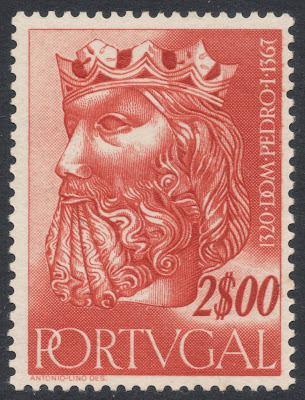
“I’ve never
really engraved a satisfactory portrait of The Queen”. This casual remark, made
in an interview for the Penrose 82 International Review of the Graphic Arts,
has haunted Alan Dow for ever. Collectors of his work have ever since been
negating his remark, but taken in the context of the interview it need not
necessarily be read as a criticism of his own engraving skills. It was more
meant to highlight the fact that he always worked from photographs and was
therefore recreating the photographer’s perception of The Queen, rather than
modelling his own. Besides, the remark seemed to have also been aimed mainly at
his work on banknotes, for no other engraver has engraved so many portraits on
banknotes of The Queen as Alan Dow.
Nigel Alan
Dow, born in London in 1929, commenced his training at the London School of
Photo-Engraving, Lithography and Commercial Art. But hardly a year into his
education he joined Bradbury Wilkinson for an initial trial period of a couple
of months. This led to a prolonged seven-year period of training with the firm,
until June 1951. During this period he enjoyed the guidance of the famous
French engraver Max Ferré. Dow once said that he felt very fortunate to have
had Ferré as his mentor. He admired his work and found that Ferré was a gifted and
inspirational teacher.
The late
1940s, early 1950s were a time when the workload for engravers increased
substantially, creating opportunities for Dow. Although officially training as
a portrait engraver, he was given vignettes to engrave when only a few years into
his apprenticeship.
Dow’s first
stamps probably date from 1947, these being stamps engraved for Ethiopia. The
problem with ascertaining which stamps should be attributed to Dow is that
there are usually no official sources to consult. The main catalogues hardly
make any mention of his name, so the little information that is around has been
dug out of archives etc., and cannot always be corroborated. However, it is
fairly certain that Dow was responsible for quite a few British Commonwealth
definitives from the early 1950s. These would include a number of stamps dating
from the late King George VI period, such as the 1½d, 2d and 2s stamps for the
Cayman Islands and the 4c and 2$40 values for Dominica.
After Dow
had finished his apprenticeship in 1951, he was given portraits to engrave. One
of the earliest ones was a portrait of Queen Salote of Tonga. The portrait was
engraved in 1951 but only appeared on a 10 shilling definitive stamp in 1953.
The list
grows substantially when we enter the early Queen Elizabeth II period. Apart
from single stamps from larger sets, such as the 2½d Bermuda stamp from 1952
and the 15m, 40m and 100m stamps from Cyprus, dating from 1955, the complete
lower values from both New Zealand (1953) and Fiji (1956) have been attributed
to Dow. If anything, these stamps show that Dow was most certainly capable of
rendering beautiful portraits of The Queen.
Dow has also engraved quite a few
stamps and definitive sets for countries outside the British Commonwealth.
Among others, he was responsible for the 1952 Libya definitives, the 1956
Morocco definitives for its southern zone, and the 1957 Iraq definitives. Most
iconic among his ‘foreign’ work is probably that done for the 1955 Kings set of
Portugal. Dow engraved the 90c and 2e values.
The die
proofs for the 2e value show how much the
basic design has been experimented with. The eventual
portrait has many more light or even unengraved areas, which light up quite
distinctly on the stamp. The background shading has been mirrored. The dark
background near the face on the die proof makes the portrait stand out less
well, so that's a very sensible change on the final design. The lettering in
the right suffers a bit as a consequence, though. But given that they couldn't
really shift it to the left side, it is probably the best solution they could
come up with.
In the 1960s, Alan Dow became Chief Engraver at Bradbury Wilkinson. During this period he engraved the 1964 Shakespeare stamp and the 1966 Westminster Abbey stamp for Great Britain, although on the latter Dow only engraved the portrait of the Queen, the vignette being engraved by Frederick Warner.
In the 1960s, Alan Dow became Chief Engraver at Bradbury Wilkinson. During this period he engraved the 1964 Shakespeare stamp and the 1966 Westminster Abbey stamp for Great Britain, although on the latter Dow only engraved the portrait of the Queen, the vignette being engraved by Frederick Warner.
When the
first British Machin high values were being prepared in the late 1960s, two
engravers were asked to create a master die: Alan Dow and Bob Godbehear. As an aid to the
engravers, the final plaster cast made by Arnold Machin was re-photographed in
such a way that the depth of the cast was more visible than on the photographs
used for the low value photogravure stamps. The engraving by Godbehear was eventually
chosen for the stamps which were issued in 1969.
In 1986, De
La Rue took over Bradbury Wilkinson. Dow, together with many other staff
members, left the company and found work at the Swedish firm Tumba Bruk, which
had offices just outside of London. After these offices folded in 1991, De La
Rue offered Dow a contract as a consultant with the guarantee of some
actual portrait engraving being agreed upon as well. Dow stayed with De La Rue
there until his retirement in 1997, but his work done during that time for
engraving banknotes rather than stamps.


